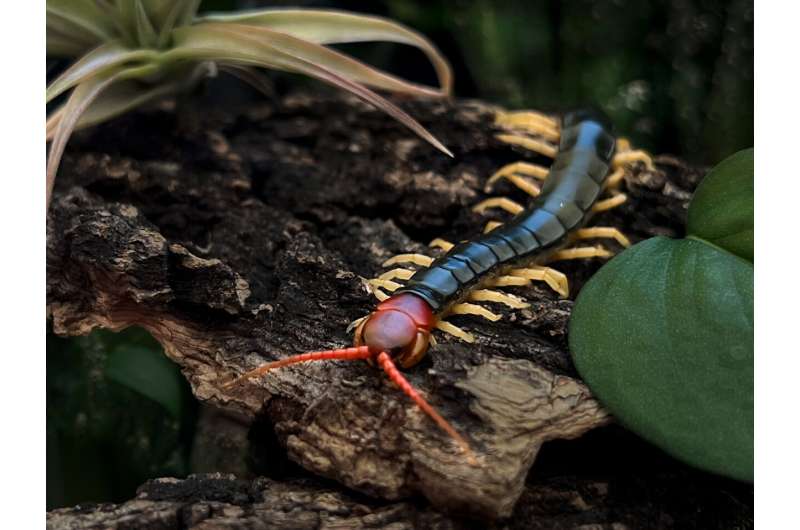February 14, 2023 report
This article has been reviewed according to Science X's editorial process and policies. Editors have highlighted the following attributes while ensuring the content's credibility:
fact-checked
peer-reviewed publication
trusted source
proofread
How eyeless centipedes are able to detect sunlight

A team of forestry experts at Northeast Forestry University, working with two colleagues from Zhejiang University School of Medicine, has uncovered the means by which the Chinese red-headed centipede is able to detect sunlight despite having no eyes or even photoreceptors.
In their paper published in Proceedings of the National Academy of Sciences, the group describes testing the myriapods under various scenarios to learn how they sense sunlight.
Venomous Chinese red-headed centipedes have long, black segmented bodies, yellow legs and a large, eyeless head with long antennae and a mouth capable of biting and injecting venom into prey, predators and humans that happen to step on them.
Prior research has shown that the centipede actively avoids sunlight, though it is not known if this is to avoid predators or prevent overheating. Prior research has also shown that in addition to having no eyes, the pencil-size bugs also have no photoreceptors, raising the question of how they know when the sun is shining on them.
To find out, the researchers conducted experiments that involved placing specimens in clear containers, some of which were covered with black tape. They then studied how the centipedes moved when exposed to differing amounts of light. They also used thermal cameras to record changes in body temperature during sunlight exposure. They found that the temperature of the antennae rose almost immediately when exposed to sunlight, and did so rapidly. Readings showed temperature increases of up to 9°C within seconds.
To confirm that the antennae were alerting the centipedes to sunlight, the researchers covered the curly red, segmented structures of several specimens and then retested the bugs to see how they responded to sudden bursts of light. The covering made the creatures far less averse to sunlight.
The researchers then took a closer look at the antennae to find out how they were working as sunlight heat sensors and found thermal receptors called BRTNaC1 that served as ion channels. They were triggered by temperature increases.
More information: Zhihao Yao et al, A thermal receptor for nonvisual sunlight detection in myriapods, Proceedings of the National Academy of Sciences (2023). DOI: 10.1073/pnas.2218948120
Journal information: Proceedings of the National Academy of Sciences
© 2023 Science X Network



















